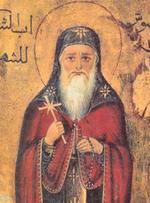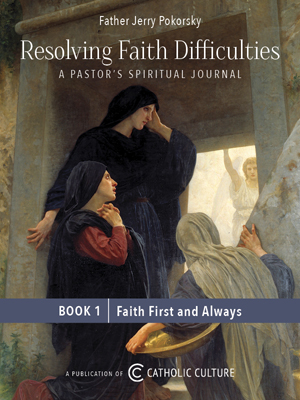Church Compositions Without Liturgical Foundation, Part Two
II. Emancipation Of Melody
Holy Church has produced, out of her own spirit, a treasure of sacred melodies. The names of the composers are not known; they were men of spiritual intuition and of ardent faith. The Proper of the Masses from Passion Sunday till Low Sunday — to mention but a small group — betrays a superhuman gift of melodic invention. The sacred words are aglow with a tonal outpouring of love and sympathy, until, in Easterweek, they are transfigured with rays of transcending joy. Great are the contrasts, but equally great is the wise moderation that tempers grief and joy. Surely a special help has been accorded those early Christian singers!
To preserve these sacred melodies for so many centuries has been for holy Church a matter of constant struggle. Being a generous Mother, she has always fostered progress. When polyphony was admitted into her sanctuary, it was done so with the understanding that it must rest on the Gregorian melodies as a common basis; that the sacred text must be well understood, that melody and rhythm (movement) must preserve the same prayerful spirit. In other words, holy Church wished to see and hear in polyphony nothing else than her own melodies in harmonic setting. The artist who succeeded more than any other in this delicate task was Palestrina. His music creates the impression of sublime prayer, the sacred words can be well understood, the harmonic texture is of such surprising beauty and purity that it animates the faithful to ever increasing fervor and devotion.
Unfortunately, another kind of melodic conception arose and captivated the hearts of men. This new style was bent on display of art — to create an impression, a surprise, a pleasurable feeling. This development started in Venice. In 1527, Adrian Willaert, born at Bruges in 1490, was nominated chapel-master to St. Mark's Cathedral. Although well trained in all the intricacies of counterpoint, his disposition was to write music in the simplest and most comprehensible style. Profane songs, and especially the madrigal (love-ditty), had particular attraction for him; for in them he had no fixed plainchant theme to tie down his imagination, and the spirited metrical form of the text, easily lending itself to simple harmony or very facile counterpoint, enabled him to bring this form of composition to a very high degree of perfection. In this way Willaert accommodated church music to that deeply rooted and already largely developed tendency of the Italian to individual expression. He also conceived the idea of dividing his choir and of writing for double chorus. The working of this plan was most successful, and the delight it gave the hearers was unbounded. To manage numerous and large masses of chorus, homo-phonic writing was naturally better adapted than polyphonic, and hence we cannot but regard the move as the opening of that new path whereon harmony would outstrip the melody and eventually gain the victory. Willaert died in 1562.
Under Joseph Zarlino ("the father of our modern scales of major and minor"), master at St. Mark's from 1565 to 1590, and especially under the two brothers Andrea and Giovanni Gabrieli, the art of building up massive choruses was still more developed. The earlier importance of each individual part in the chorus became secondary; the harmonic working of the whole, primary. In this preference given to the simultaneous setting of parts, the melodic independence and importance of each part had no further place. The harmonic effect was alone considered; hence chords and modulations, foreign to the diatonic scale, began to appear as a necessary consequence; hence, also, the adoption of a new principle, the principle of harmony regulating the construction of the melody, and this even in the principal part. The liturgical chant became good for nothing in the new system. Gabrieli himself invented the musical expression for the liturgical text, which, although religious and solemn enough, is nevertheless subjective and individual. Even the Arioso solo comes to the front, timidly no doubt, but occasionally. Here, then, is the turning point. The famous Dr. A. W. Ambros, in the third volume of his History of Music, says: "Gabrieli prays, and we all pray with him. Let a man take the same text as handled by Palestrina, and he will see at a glance the enormous difference; for Palestrina is the last and purest reverberation of that other and older rule. In Gabrieli we are forewarned of the coming musical emancipation of the individual."
Venice started the emancipation; Florence furnished the theory. Friends of classic lore (in the latter city), dissatisfied with the relation heretofore existing between poetry and music, formed themselves into an academy for promoting the closer union between the two arts by the revival of "musical declamation of the Greeks." Music, they asserted, should be in a position to express adequately all the feelings and all the passions of any man in action. This naturally implied the freest declamatory form, and a form, which should not be tied down to any fixed tonality. It implied, moreover, unison, or one-part song, accompanied by instruments or even by other voices, provided they did not wander free "in the sweet liberty of counterpoint." Counterpoint, in their opinion, destroyed all poetry. They found men skilled in the art of music ready to forward these ideas. Foremost among them was Vincenzo Galilei, father of the renowned astronomer; then Caccini, a Roman singer; and above all, Jacopo Peri and Emilio del Cavaliere, court chapel-master in Florence. These men put the theories of the academy into practical shape by producing lyric works of an experimental character, and thus laying the foundation of our modern opera and oratorio. The same men (as a rule) wrote court music and church music, the Church being the loser.
The man who completely abolished the old ecclesiastical modes and reduced them to two, our major and minor, was Claudio Monteverde, chapel-master of St. Mark's in Venice until his death in 1649. Instead of the traditional Gregorian chant and its peculiar character, we get the profane aria or song; instead of the rich treasury of the church modes, we are presented with the meagre selection of major and minor; instead of the exclusively diatonic character of the Church's song, we get the new chromatic tonality; instead of the truly artistic counterpoint, we get the much preferred practice of homophonous harmony or easy fuge; instead of the essentially antique harmonies — the result of the voices moving independently — we get an independent harmony which claims the air for itself. And in proportion as the appreciation of the liturgy began (about the same time) to grow fainter, in the same proportion composers for the Church drew the line between sacred and secular music, at a point where there remained enough of devotion and earnestness to give it the character of what we might call "religious passion." The old and the new church music had become irreconcilable; the toleration of the new school in the Church practically excluded the time-honored chant of the Church and thoroughly secularised this department of public worship. We call Monteverde the highest exponent of the reform: the central figure and starting-point of modern musical science. "Without Monteverde," says William Rockstro (1825-1895) in his General History of Music, "we could have had no Handel, no Bach, no Haydn, no Mozart, no Beethoven. He brought on an ever-increasing tendency toward the chord of the dominant seventh and its inversions, which give a curiously modern effect to the cadences in which they constantly occur."
We have given in a nutshell the history of melodic emancipation. How it worked out may be visualized by turning over the pages of some of these composers, including Haydn, Mozart and Beethoven; melody has become independent, a free lance. How could the good Lord endure all this theatrical and worldly display? He, after all, is the only one who listened to every note; He accepted or rejected what was offered. No doubt, there have been well-intentioned composers, devout singers and devout listeners — children of their time, a time of long sermons and of still longer music. Haydn's teacher, the famous Porpora, had musically linked Vienna with Naples; Mozart composed under strict orders from the Prince-Archbishop, a lover of grand court display; Beethoven was a giant of independent character, without knowledge of liturgical laws. Our age is of a different type. America, in the nineteenth century, led with the short story, as the history of literature testifies; missionaries preached practical and short sermons; last but not least, there came to us with Gregorian chant the short music so well fitted for an expeditious race.
Gregorian melody has a directness and naturalness not found in any other form of music. Take the simple Salve Regina or the Veni Creator: what beauty in the one, what vigor in the other! The ecstatic Pange Lingua and the worshipful O Salutaris are a triumph of melodic invention. Take the hymns of Advent, Christmas, Easter, and watch the melodic spirit; you hear quite plainly the echo of the holy season. How reposeful, how comforting, is the Introit Requiem Aeternam, and what shall we say of the farewell-song In Paradisum? It is a master stroke of sacred diplomacy: the heavenly gates are thrown open, we behold a scene of reception into glory, we forget all about mourning and are in spirit transported into the midst of angels and saints. Thus a homesickness for heaven is created in the mourners; faith and hope are strengthened, and the way to the cemetery is turned into a triumphant escort. In truth, the Gregorian melodies never grow old; like a garment of glory they never wear out; their fragrance, like that of the rose, arises from the sacred words which they keep in undying bloom.
Our friend, the composer, whom we met in the first article, and every other church musician, ought to consult these very melodies and be filled with their spirit, and only then start to compose for the Church. "We may with good reason establish as a general rule," says Pius X in his Motu Proprio, "that the more a musical composition for use in church is like plainchant in its movement, its inspiration, and its feeling, so much the more is it right and liturgical; and the more it differs from this highest model, so much the less is it worthy of the house of God."
Apropos:
1. Mozart's Twelfth Mass stands convicted of many crimes. Jahn and Nohl, the principal biographers of Mozart, have long rejoiced that their hero has been exonerated from perpetrating a misdeed of such musical inferiority. The culprit who did business under a big name has not been ultimately identified. The Mass has never been enumerated in any authentic list of Mozart's musical works.
2. About the middle of the nineteenth century, matters connected with church music were still deplorable. A traveler, who assisted at High Mass in the Church of the Holy Sepulchre in Jerusalem, was horrified to hear the organist render as an Offertory, Arditi's Kiss Waltz. You might ask: "Who was the Hottentot of an organist that perpetrated such a thing?" We have but one answer to offer: "The Hottentot's name was 'Bad Taste'." This same Hottentot provided also big music for the Western Church, wherever he could get a foothold. It was considered (in certain places) a necessary festive adjunct to perform at the Offertory a romanza or an overture of some famous opera.
3. "Meminisse juvat — It is profitable to remember" that holy Church had on hand a giant struggle against decadent music. Cardinal Bona (d. 1678) was one to witness fallen church music; he lamented the fact that worldly and silly melodies had entered the very sanctuary, and dainty rhythms, like dancing nymphs, had found their way into the Holy of Holies.
Church Compositions Without Liturgical Foundation, Part One
This item 4313 digitally provided courtesy of CatholicCulture.org






